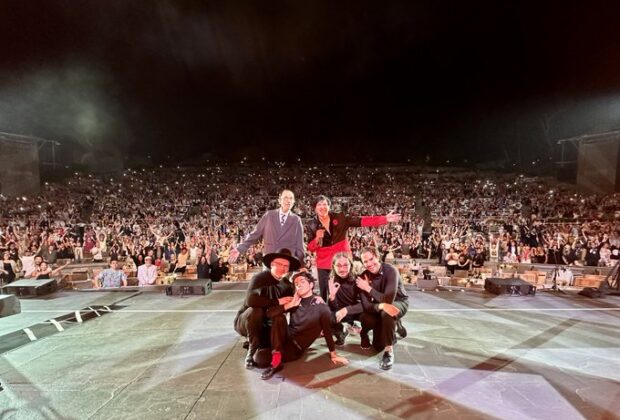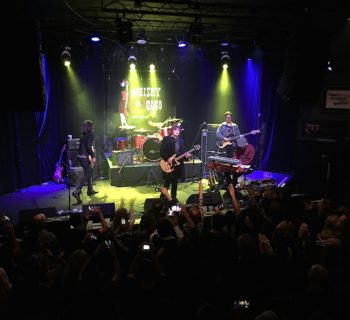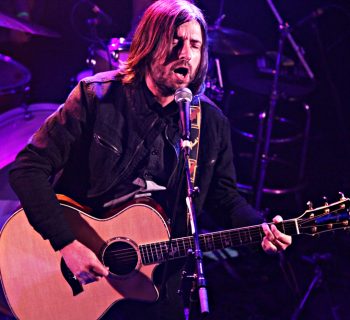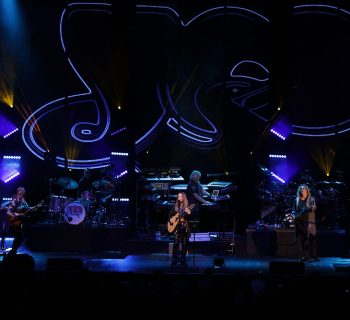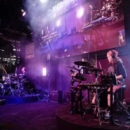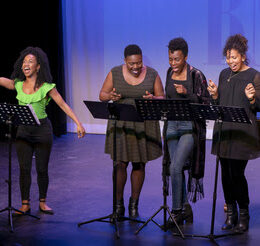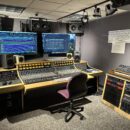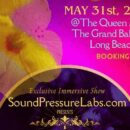Is it possible for a band to care so much that they have no more fucks to give? Is it possible that a band have no more fucks to give because they care so much?
That’s what I was wondering when looking back at the setlist of the Sparks at The Hollywood Bowl, their final U.S. date before heading to Tokyo. You can’t exactly call it a comeback, as LL Cool J once rapped, they’ve been here for years. In fact, while most legacy acts have some dips in their careers, the brothers Ron and Russell Mael have been on an upswing for the last two decades of their five-decade span, and they’ve been absolutely prolific in the last couple of years; with their musical film, Annette, their 25th album (The Girl Is Crying in Her Latte), their Edgar Wright directed, glowing documentary, The Sparks Brothers, which may be a big reason why they are playing their biggest and most prestigious venues ever, like Royal Albert Hall across the pond, and here in their hometown, nestled within the hills at The Hollywood Bowl. If it’s not a comeback, maybe it’s best to describe it as a Renaissance, because when most other artists their age are getting ready for gold watches and early bird specials, the Brothers Sparks are flourishing, and showing no signs of slowing down.
Which brings us back to their spectacular show and surprising setlist, which instead of a retrospective of their biggest hits (whatever that means for this band that never really set out to make hits), consisted of a handful of songs from their new album and was rounded out with songs from records that most people wouldn’t know anything about, or that only forgiving completists would have interest in. Don’t get me wrong, some of these songs did chart when they came out, but for the most part, instead of playing that big retrospective show at the big Hollywood Bowl, the set showcased deep cuts and obscurities. If you read my cover story/interview with them in this magazine a few months ago, you may understand how it happened. First, when rehearsing for their huge undertaking of performing 21 albums in 21 days in London back in 2008, Ron told me how they had found a new respect for some of these lesser-known songs/albums. He reasoned that they were overlooked, not because they weren’t good, but because of other reasons like lack of promotion for example. That series of shows was a good time to reintroduce them into the sets, it was a good time to celebrate them as part of the canon. Also, since the Sparks Brothers documentary brought in a new wave of fans who have no sacred cows or blind spots regarding the catalog, they can more easily accept these songs in a set without pre-judgement. Lastly, aside from this exercise in paying tribute to their full catalog for those 21 days, they are not a retro/greatest hits band, they may play old cuts because whenever they play them they are still new cuts, not because they are prone to wax nostalgic. Thus, they play more songs from their new albums than they do their classic stuff. And, unlike other bands who are afraid to present the new stuff, lest you go take a leak, Sparks expect you to come along for the ride or get left behind.
And for the most part, I think it works for them. After opening with the hype-building, and appropriately titled “So May We Start,” from Annette, they went right into the title track of their latest. A Gen Z girl sitting next to me turned to me and raved, “Isn’t this awesome! I love their new album.” It was proof that this band, that could sometimes be a quirky little secret, is still making new fans and making new music that “the kids” (even) like.
“Angst in My Pants,” made me leap out of my seat. The song represents Sparks’ New Wave period, but let me put that in a little context with a quick recap of their origin story: Ron and Russell are Angelinos, having grown up in the Pacific Palisades and educated at UCLA (Go Bruins!). Obsessed with the British Invasion (of course, The Beatles, but mostly The Who, The Kinks and the Move) buying all those records as imports as soon as they became available, until they actually became British Imports. Talk about visualization. You see, despite Cali’s tendency to quake, there was no seismic activity upon the release of Sparks’ first two albums, so they went over to London where they found opportunity-cum-stardom as a British glitter/glam, band starting with their breakout album, Kimono My House, for Island. As such, many (if not most) American fans didn’t know they were buying records by expatriates; they thought they were buying British imports from a British band that was part of the Bowie, T. Rex, Roxy Music, Sweet, Slade, and Queen zeitgeist.
That POV continued even when they came home and domesticated themselves as a sort-of punk/new wave (as in stripped down rock), playing places like Whisky a Go Go in L.A. and The Bottom Line in N.Y.C. Then, after hearing Donna Summer’s futuristic disco hit, “I Feel Love,” they hooked up with its producer, Giorgio Moroder, with whom they collaborated on a string of albums that would have much more influence than actual sales. The first of which, No. 1 in Heaven, was a proto-trance/eurodisco masterpiece that, like Kraftwerk and Moroder’s other albums, would have a profound effect on the emerging synth-pop/new wave bands from the U.K. (think Joy Division/New Order, Pet Shop Boys, Duran Duran, OMD, and you’re only getting started) that, when they all scored hits via MTV, would be described as the Second British Invasion. “Angst in My Pants” came out this period, and “Cool Places” (with Jane Wiedlin of the Go Go’s) capped off this period that when after hearing them on KROQ (Rodney On The ROQ or Richard Blade’s shows) Valley Girls shopping at the Sherman Oaks Galleria would/could assume, once again, that Sparks were a British band that were part of the same scene as those other U.K. synth-pop bands.
Personally, I was hoping that the Maels would part from this tour’s usual setlist and celebrate this era for the Hollywood Bowl show, being that it was such a special time for them and their L.A. fans. But, as I said, they’re not a nostalgic band, despite being sentimental about the moment. Taking in the moment, Russell reflected, “It’s an absolute thrill to be here tonight. Our hometown. And our mother took us to this very venue in 1964 when The Beatles played, and I think that was some good education from our mom, and it led to this, our being on the stage right now, so thank you all.”
They did go back to their beginnings again, for “Beaver O’Lindy,” from their sophomore album, A Woofer in Tweeter’s Clothing. The stage was sparse but striking, with letters in lights that would spell out the song’s title. This was also perhaps the most hard-rocking song of the night, true power pop dynamics ala Keith Moon, Pete Townsend and The Who. Though the audience couldn’t help but be titillated by this old-school deep cut, I have to complain, not about the band but the crowd––I kept waiting for the audience to wake up. They were half asleep there for a while. It was me and a handful of others who were elated to hear “When I’m With You.” The song comes from their second Moroder record, Terminal Jive, an album that’s even maligned by Sparks fans, but some of us think it’s the buried treasure of their discography. Like 10CC’s “I’m Not in Love” the song goes meta in deconstructing the very notion of a love song. It’s smart pop perfection, that was played a bit slower tonight than on the album. Terminal Jive went unnoticed here in The States but was huge in France, where the Maels lived, off promoting its success for a year.
Actually, Sparks had a lot of balls to play this setlist––literally, they did their song “Balls” off the album title of the same name. “Balls” had them keeping up with the then current sounds of electronica at the new Millennium, specifically The Prodigy. I’m not sure if most of the crowd new the track, but they seemed to enjoy it. Ron took the spotlight to deliver his hilarious, deadpan musings of modern love circa 1986. From the album, Music That You Can Dance To, it sounds much better today than it did when it was first released. It aged well, despite sounding dated, especially when you consider it a continuation of their pioneering electronica starting with No. 1 In Heaven and continuing to that point in ‘86. I think when it came out the majority of Sparks fans were not dance pop fans, so the record had a better audience with the club music crowd than it did their own fans. But time is a great equalizer and looking back, when you listen in context to their other rock and new wave albums, you can see how it is no different a brilliant Sparks album than the other greats. The title track, which they performed a couple songs later, was the beginning of what can be described as the “dance” portion of the set, where they did “When Do I Get to Sing ‘My Way’” as well as No. 1’s “The Number One Song in Heaven.” And this is where the crowd was finally alive and on their feet, giving Sparks back that explosive energy they were receiving.
I don’t want to come off as ageist, but I reminded myself a couple times that these brothers are no spring chickens, and yet there was Russell dancing and jumping around like Jack Be Nimble, and there was Ron doing his signature dance with the same zeal he did decades ago. And vocally? It’s not every day we get to report that the lead singer sounds as good as he ever did, where aside from running circles around his contemporaries, Russell can still hit the highs and has the breath power to pull-off those acrobatic and chromatic tongue twisters. And the band that backs them up are tight. While I’m always curious in how a band approaches the live representation of electronic dance music––I tend to wish that the electronic stuff was presented more electronically live––I have to admit, the live translation of the electronic music was powerful and impressive coming from a “band” setting.
With the crowd up on its feet and dancing the night away, the boys topped it all off with their most famous number, “This Town Ain’t Big Enough for Both of Us,” from 1974’s Kimono My House. The audience erupted, and it was every bit as climactic as the fans and the brothers would have wanted. Which set up the final song (before encores) perfectly. “Gee, That Was Fun” with its lyrics, “Gee, that was fun, being with you all this time.” Sparks is a band known for their quirky humor, their social commentary, their satire. But that should not be mistaken for detachment or coldness. Many of these songs are more sincere than you would initially give them credit for, and hearing the brothers talk, the emotion in their voices about how honored and humbled they were about achieving such a career milestone, to be hometown heroes playing the Hollywood Bowl––there is no way not to become emotional with them.
Their last of two encores was “All That,” from Covid era’s (2020) A Steady Drip, Drip, Drip. A song Russell intro’d by saying, “It encapsulates how we feel emotionally about an evening like tonight. It’s so amazing, the bond that we have with you guys is something extra special.” It’s a song that my wife would cry tears of joy to as we listened in the car, because it fills you with the feels of mindful gratitude. And the brothers were saturated with gratitude as the Bowl lit up with cell phone lights the way Bic lighters would light up arenas back in the day. You could tell they were overwhelmed by it, “It looks absolutely beautiful up there, thank you,” Russell said as he led us in the night’s final singalong.
It may have taken their whole career to get to this point of playing The Hollywood Bowl, but this fan can’t wait for them to make it just another stop on their next tour, so we can appreciate whatever setlist this legendary duo offers. Because any night with Sparks is a once in a lifetime night that we hope we can experience at least twice! •
Photo by Edgar Wright

